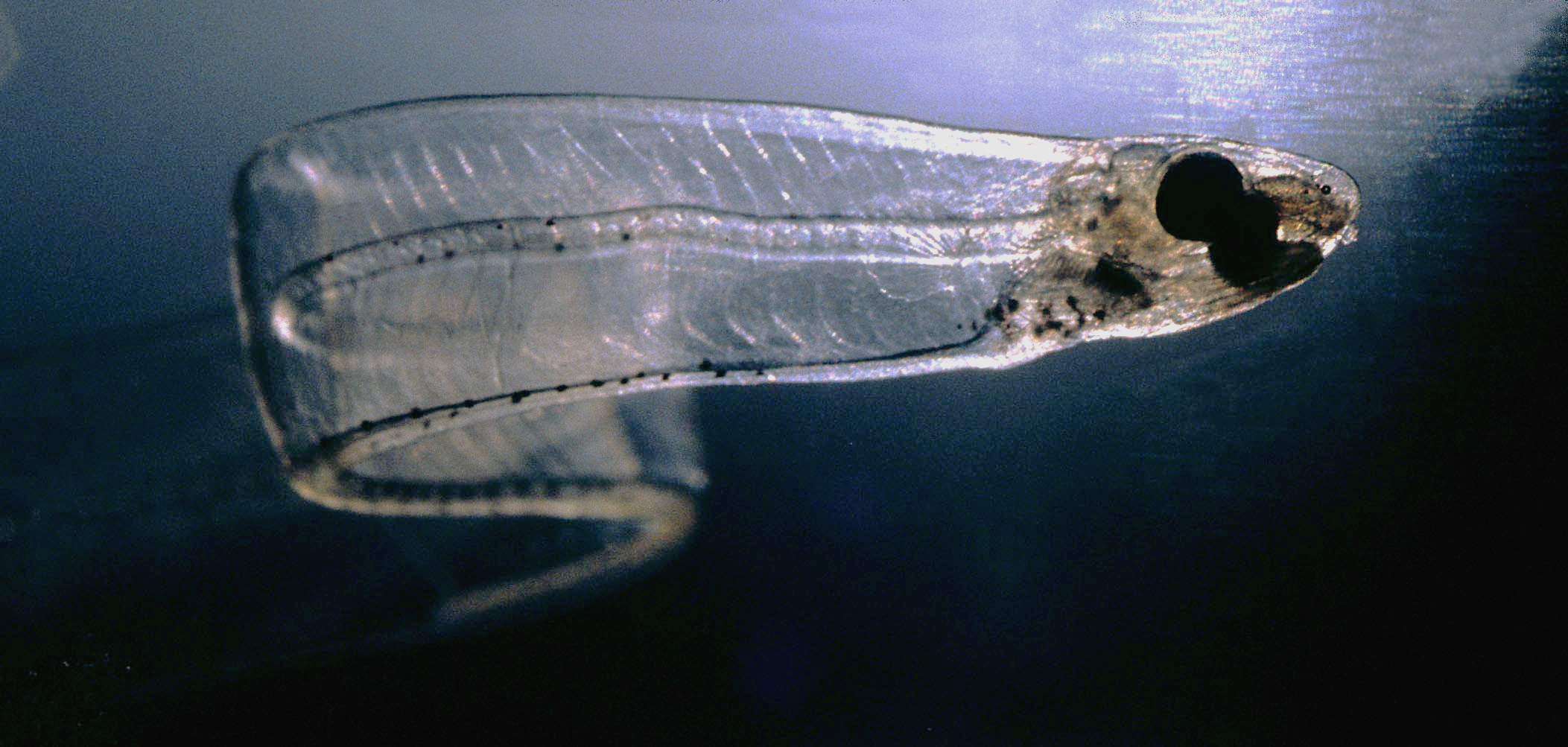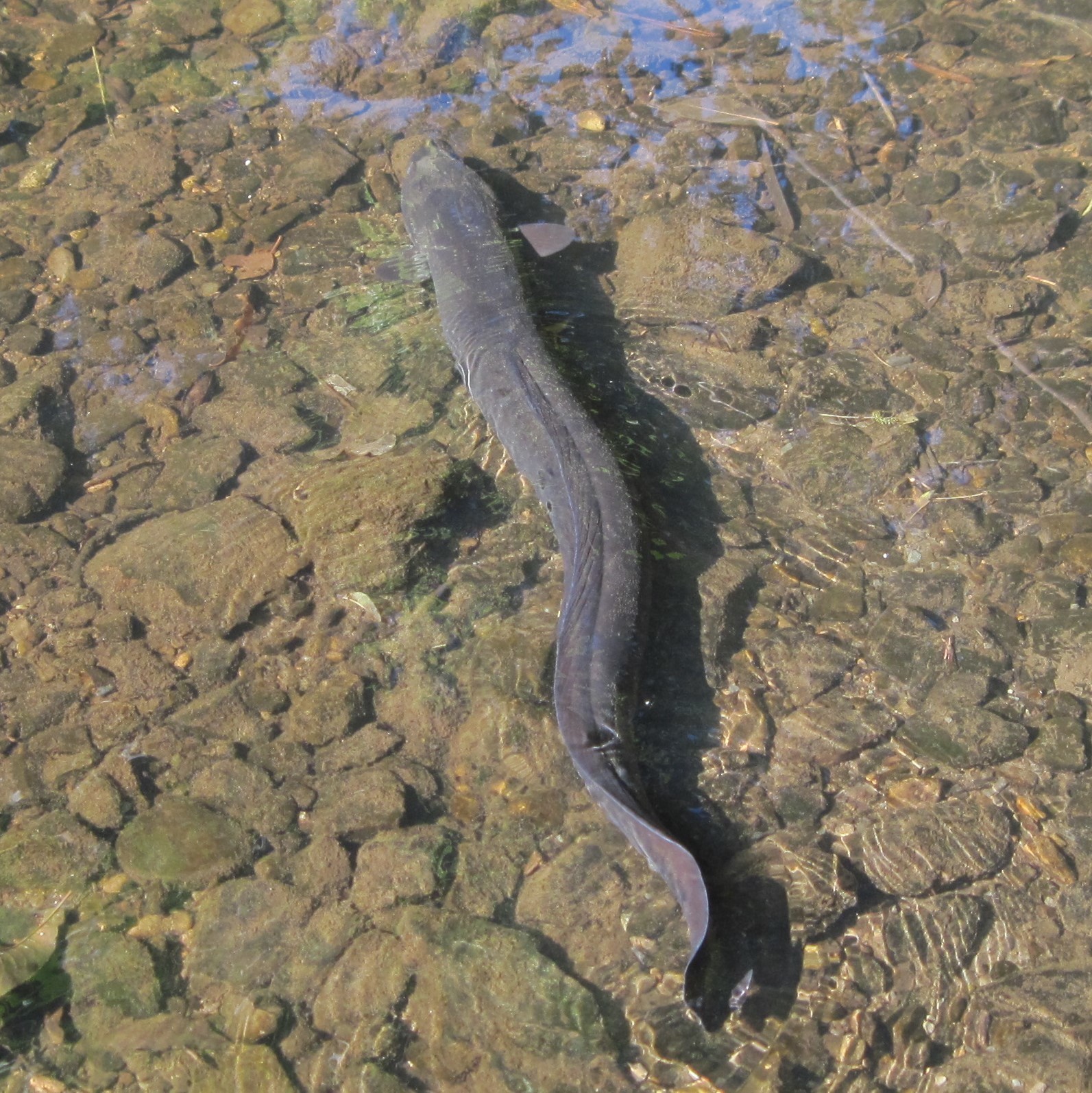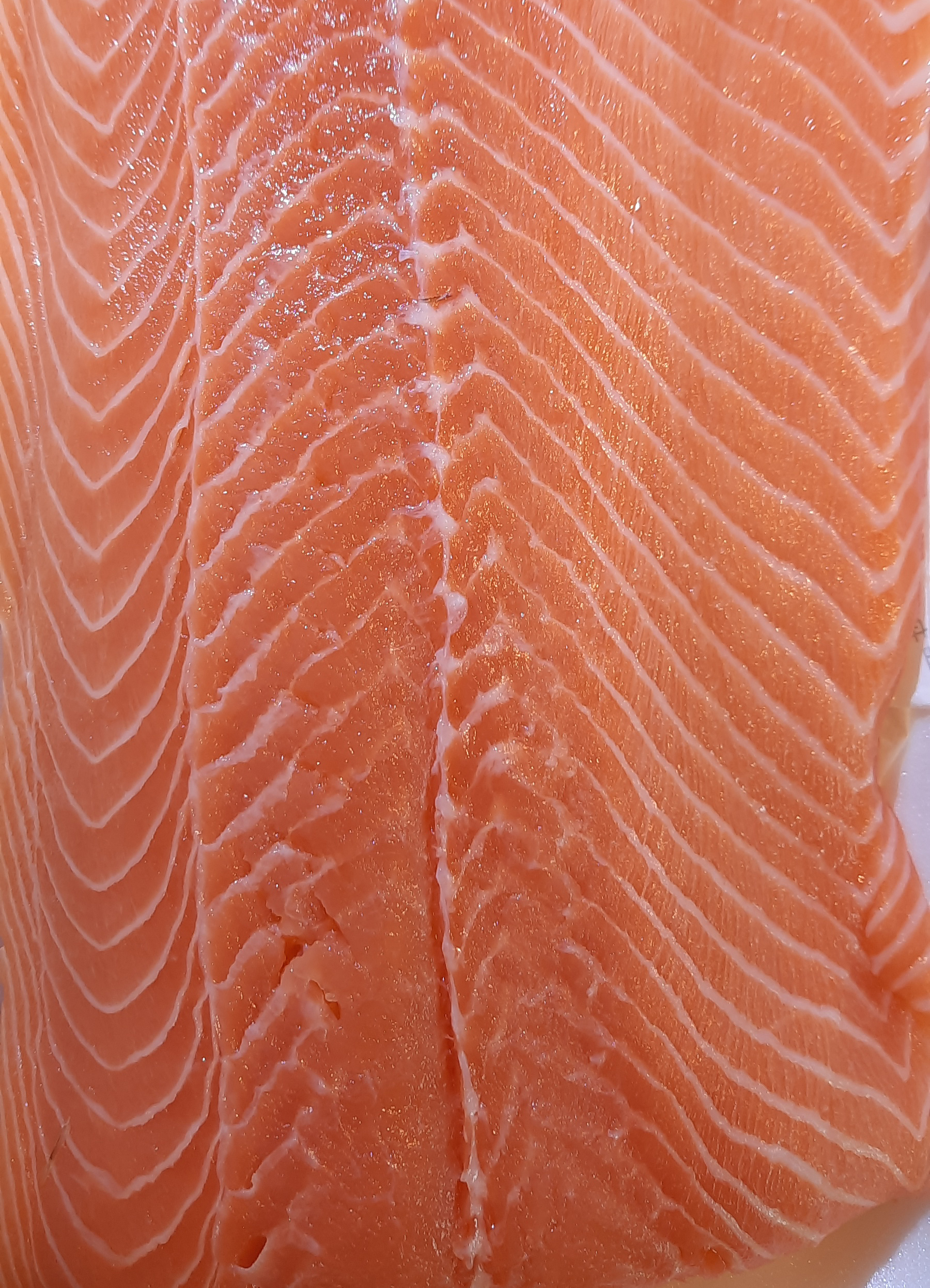|
Leptocephali
Leptocephalus (meaning "slim head") is the flat and transparent larva of the eel, marine eels, and other members of the superorder Elopomorpha. This is one of the most diverse groups of teleosts, containing 801 species in 4 orders, 24 families, and 156 genera. This group is thought to have arisen in the Cretaceous period over 140 million years ago.Inuoe, Jun, M. Miya, et al. “Mitogenomic evidence for the monophyly of elopomorph fishes (Teleostei) and the evolutionary origin of the leptocephalus larva.” Molecular Phylogenetics and Evolution 32 (2004): 274-286. Web. 2 Nov. 2012. Fishes with a leptocephalus larval stage include the most familiar eels such as the conger, moray eel, and garden eel as well as members of the family Anguillidae, plus more than 10 other families of lesser-known types of marine eels. These are all true eels of the order Anguilliformes. Leptocephali of eight species of eels from the South Atlantic Ocean were described by Meyer-Rochow The fishes of ... [...More Info...] [...Related Items...] OR: [Wikipedia] [Google] [Baidu] |
Anguillidae
The Anguillidae are a family of ray-finned fish that contains the freshwater eels. Eighteen of the 19 extant species and six subspecies in this family are in the genus ''Anguilla''. They are elongated fish with snake-like bodies, their long dorsal, caudal and anal fins forming a continuous fringe. They are catadromous fish, spending their adult lives in freshwater, but migrating to the ocean to spawn. Eels are an important food fish and some species are now farm-raised, but not bred in captivity. Many populations in the wild are now threatened, and Seafood Watch recommend consumers avoid eating anguillid eels. Physical description Adult freshwater eels are elongated with tubelike, snake-shaped bodies. They have large, pointed heads and their dorsal fins are usually continuous with their caudal and anal fins, to form a fringe lining the posterior end of their bodies. They have relatively well developed eyes and pectoral fins compared to saltwater eels that they use to navigate ... [...More Info...] [...Related Items...] OR: [Wikipedia] [Google] [Baidu] |
Myomere
Myomeres are blocks of skeletal muscle tissue arranged in sequence, commonly found in aquatic chordates. Myomeres are separated from adjacent myomeres by connective fascia (myosepta) and most easily seen in larval fishes or in the olm. Myomere counts are sometimes used for identifying specimens, since their number corresponds to the number of vertebrae in the adults. Location varies, with some species containing these only near the tails, while some have them located near the scapular or pelvic girdles. Depending on the species, myomeres could be arranged in an epaxial or hypaxial manner. Hypaxial refers to ventral muscles and related structures while epaxial refers to more dorsal muscles. The horizontal septum divides these two regions in vertebrates from cyclostomes to gnathostomes. In terrestrial chordates, the myomeres become fused as well as indistinct, due to the disappearance of myosepta. Shape The shape of myomeres varies by species. Myomeres are commonly zig-zag, " ... [...More Info...] [...Related Items...] OR: [Wikipedia] [Google] [Baidu] |
Metamorphose
Metamorphosis is a biological process by which an animal physically develops including birth or hatching, involving a conspicuous and relatively abrupt change in the animal's body structure through cell growth and differentiation. Some insects, fish, amphibians, mollusks, crustaceans, cnidarians, echinoderms, and tunicates undergo metamorphosis, which is often accompanied by a change of nutrition source or behavior. Animals can be divided into species that undergo complete metamorphosis (" holometaboly"), incomplete metamorphosis ("hemimetaboly"), or no metamorphosis (" ametaboly"). Scientific usage of the term is technically precise, and it is not applied to general aspects of cell growth, including rapid growth spurts. Generally organisms with a larva stage undergo metamorphosis, and during metamorphosis the organism loses larval characteristics. References to "metamorphosis" in mammals are imprecise and only colloquial, but historically idealist ideas of transformation an ... [...More Info...] [...Related Items...] OR: [Wikipedia] [Google] [Baidu] |
Dorsal Fin
A dorsal fin is a fin located on the back of most marine and freshwater vertebrates within various taxa of the animal kingdom. Many species of animals possessing dorsal fins are not particularly closely related to each other, though through convergent evolution they have independently evolved external superficial fish-like body plans adapted to their marine environments, including most numerously fish, but also mammals such as cetaceans (whales, dolphins, and porpoises), and even extinct ancient marine reptiles such as various known species of ichthyosaurs. Most species have only one dorsal fin, but some have two or three. Wildlife biologists often use the distinctive nicks and wear patterns which develop on the dorsal fins of large cetaceans to identify individuals in the field. The bony or cartilaginous bones that support the base of the dorsal fin in fish are called ''pterygiophores''. Functions The main purpose of the dorsal fin is to stabilize the animal against rollin ... [...More Info...] [...Related Items...] OR: [Wikipedia] [Google] [Baidu] |
Carl Linnaeus
Carl Linnaeus (; 23 May 1707 – 10 January 1778), also known after his ennoblement in 1761 as Carl von Linné Blunt (2004), p. 171. (), was a Swedish botanist, zoologist, taxonomist, and physician who formalised binomial nomenclature, the modern system of naming organisms. He is known as the "father of modern taxonomy". Many of his writings were in Latin; his name is rendered in Latin as and, after his 1761 ennoblement, as . Linnaeus was born in Råshult, the countryside of Småland, in southern Sweden. He received most of his higher education at Uppsala University and began giving lectures in botany there in 1730. He lived abroad between 1735 and 1738, where he studied and also published the first edition of his ' in the Netherlands. He then returned to Sweden where he became professor of medicine and botany at Uppsala. In the 1740s, he was sent on several journeys through Sweden to find and classify plants and animals. In the 1750s and 1760s, he continued to collect an ... [...More Info...] [...Related Items...] OR: [Wikipedia] [Google] [Baidu] |
Anguilla Anguilla
The European eel (''Anguilla anguilla'') is a species of eel, a snake-like, catadromous fish. They are normally around and rarely reach more than , but can reach a length of up to in exceptional cases. Eels have been important sources of food both as adults (including jellied eels of East London) and as glass eels. Glass-eel fishing using basket traps has been of significant economic value in many river estuaries on the western seaboard of Europe. While the species' lifespan in the wild has not been determined, captive specimens have lived over 80 years. A specimen known as "the Brantevik Eel" lived for 155 years in the well of a family home in Brantevik, a fishing village in southern Sweden. Conservation status The European eel is a critically endangered species. Since the 1970s, the numbers of eels reaching Europe is thought to have declined by around 90% (possibly even 98%). Contributing factors include overfishing, parasites such as ''Anguillicola crassus'', barrier ... [...More Info...] [...Related Items...] OR: [Wikipedia] [Google] [Baidu] |
Sargasso Sea
The Sargasso Sea () is a region of the Atlantic Ocean bounded by four currents forming an ocean gyre. Unlike all other regions called seas, it has no land boundaries. It is distinguished from other parts of the Atlantic Ocean by its characteristic brown ''Sargassum'' seaweed and often calm blue water. The sea is bounded on the west by the Gulf Stream, on the north by the North Atlantic Current, on the east by the Canary Current, and on the south by the North Atlantic Equatorial Current, the four together forming a clockwise-circulating system of ocean currents termed the North Atlantic Gyre. It lies between 20° and 35° north and 40° and 70° west and is approximately wide by long. Bermuda is near the western fringes of the sea. While all of the above currents deposit marine plants and refuse into the sea, ocean water in the Sargasso Sea is distinctive for its deep blue color and exceptional clarity, with underwater visibility of up to 61 m (200 ft). It is a ... [...More Info...] [...Related Items...] OR: [Wikipedia] [Google] [Baidu] |
Marine Snow
In the deep ocean, marine snow (also known as "ocean dandruff") is a continuous shower of mostly organic detritus falling from the upper layers of the water column. It is a significant means of exporting energy from the light-rich photic zone to the aphotic zone below, which is referred to as the biological pump. Export production is the amount of organic matter produced in the ocean by primary production that is not recycled ( remineralised) before it sinks into the aphotic zone. Because of the role of export production in the ocean's biological pump, it is typically measured in units of carbon (e.g. mg C m−2 d−1). The term was first coined by the explorer William Beebe as he observed it from his bathysphere. As the origin of marine snow lies in activities within the productive photic zone, the prevalence of marine snow changes with seasonal fluctuations in photosynthetic activity and ocean currents. Marine snow can be an important food source for organisms living in th ... [...More Info...] [...Related Items...] OR: [Wikipedia] [Google] [Baidu] |
Larvacea
Larvaceans, class Appendicularia, are solitary, free-swimming tunicates found throughout the world's oceans. Like most tunicates, larvaceans are filter feeders. Unlike most other tunicates, they live in the pelagic zone, specifically in the photic zone, or sometimes deeper. They are transparent planktonic animals, generally less than in body length, excluding the tail. Anatomy The adult larvaceans resemble the tadpole-like larvae of most tunicates. Like a common tunicate larva, the adult Appendicularia have a discrete trunk and tail. Larvaceans produce a "house" made of mucopolysaccharides and cellulose. In most species, the house surrounds the animal like a bubble. Even for species in which the house does not completely surround the body, such as ''Fritillaria'', the house is always present and attached to at least one surface. These houses are discarded and replaced regularly as the animal grows in size and its filters become clogged; in ''Oikopleura'', a house is kept for ... [...More Info...] [...Related Items...] OR: [Wikipedia] [Google] [Baidu] |
Zooplankton
Zooplankton are the animal component of the planktonic community ("zoo" comes from the Greek word for ''animal''). Plankton are aquatic organisms that are unable to swim effectively against currents, and consequently drift or are carried along by currents in the ocean, or by currents in seas, lakes or rivers. Zooplankton can be contrasted with phytoplankton, which are the plant component of the plankton community ("phyto" comes from the Greek word for ''plant''). Zooplankton are heterotrophic (other-feeding), whereas phytoplankton are autotrophic (self-feeding). This means zooplankton cannot manufacture their own food but must eat other plants or animals instead — in particular they eat phytoplankton. Zooplankton are generally larger than phytoplankton, most are microscopic, but some (such as jellyfish) are macroscopic and can be seen with the naked eye. Many protozoans (single-celled protists that prey on other microscopic life) are zooplankton, including zooflagellates, fo ... [...More Info...] [...Related Items...] OR: [Wikipedia] [Google] [Baidu] |
Fish Larvae
Ichthyoplankton (from Greek: ἰχθύς, , "fish"; and πλαγκτός, , "drifter") are the eggs and larvae of fish. They are mostly found in the sunlit zone of the water column, less than 200 metres deep, which is sometimes called the epipelagic or photic zone. Ichthyoplankton are planktonic, meaning they cannot swim effectively under their own power, but must drift with the ocean currents. Fish eggs cannot swim at all, and are unambiguously planktonic. Early stage larvae swim poorly, but later stage larvae swim better and cease to be planktonic as they grow into juveniles. Fish larvae are part of the zooplankton that eat smaller plankton, while fish eggs carry their own food supply. Both eggs and larvae are themselves eaten by larger animals. Fish can produce high numbers of eggs which are often released into the open water column. Fish eggs typically have a diameter of about . The newly hatched young of oviparous fish are called larvae. They are usually poorly formed, c ... [...More Info...] [...Related Items...] OR: [Wikipedia] [Google] [Baidu] |
Glass Eel
The eel is a long, thin bony fish of the order Anguilliformes. The species has a catadromous life cycle, that is: at different stages of development migrating between inland waterways and the deep ocean. Because fishermen never caught anything they recognized as young eels, the life cycle of the eel was a mystery for a very long period of scientific history. Past studies of eels The European eel (''Anguilla anguilla'') was historically the one most familiar to Western scientists, beginning with Aristotle, who wrote the earliest known inquiry into the natural history of eels. He speculated that they were born of "earth worms", which he believed were formed of mud, growing from the "guts of wet soil" rather than through sexual reproduction. Many centuries passed before scientists were able to demonstrate that such spontaneous generation does not occur in nature. In 1777, the Italian Carlo Mondini located an eel's ovaries and demonstrated that eels are a kind of fish. In 1876, as a ... [...More Info...] [...Related Items...] OR: [Wikipedia] [Google] [Baidu] |










.jpg)
